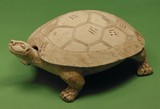
 |
Chinese (Han dynasty) Tortoise-Shaped Inkstone 206 B.C.-A.D. 220 Gray earthenware 4 inches high, 10 inches long William Hood Dunwoody Fund 32.54.4a,b |
The inkstone was one of the four valued tools ("Four Treasures") of the Chinese scholar, along with the inkstick, brush, and paper. A scholar used the inkstone to grind and mix ink for writing. The ink was made from pine soot, compressed with an adhesive gum into a dry cake or stick. The inkstick was crushed inside the receptacle while water was added from a dropper. The scholar used an extremely sensitive brush to produce an elegant form of writing called CALLIGRAPHY. The flexibility of the brush depended on the type of hair used for the bristles, with which the writer produced all variety of downstrokes and upstrokes.
Inkstones found in tombs tell us that many scholars of the first and second centuries A.D. practiced calligraphy, which along with painting was considered one of the highest arts. While painting was used to reflect moral concerns, calligraphy revealed the style and character of the artist. This difference parallels the dominant emerging philosophies of the day, Daoism and Confucianism, which became the cornerstones of Chinese thought. The two differ widely in purpose and practice; while Confucianism stresses morality, conformity, and duty toward the state, Daoism emphasizes individualism, nonconformity, and the relationship of humans to nature.4
During the earlier Qin dynasty, the emperor persecuted Confucian scholars and burned their writings. Han emperors, who encouraged learning, science, and medicine, reestablished their former place of honor in the court. The tortoise-shaped inkstone is a rare testament to the significant position of the scholar in Chinese society.
Notes
4. For a brief summary of Daoism and Confucianism, see Marilyn Stokstad, Art History (New York: Harry N. Abrams, 1995), pp. 404- 405

Key ideas.
Where does it come from?
What does it look like?
How was it used?
How was it made?
Discussion questions.
Additional resources.
Select another piece.